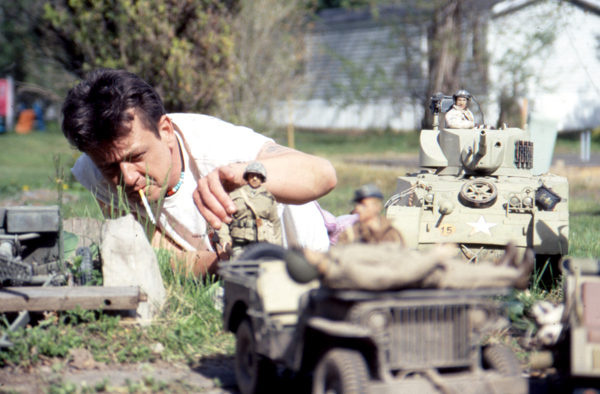|
Reviews of Recent Independent, Foreign, & Documentary Films in Theaters and DVD/Home Video

MARWENCOL A decade ago, Mark Hogancamp, then 38 years old, was viciously beaten by five young men outside a bar in Kingston, New York, two hours north of Manhattan. He was in a coma for several days with severe brain damage and, upon regaining consciousness, had to basically relearn everything once again to become a functioning adult. He also had little memory of who he was. Since he was unable to afford any kind of standard therapy, Hogancamp decided on an unorthodox form of self-help by re-creating an entire (fictional) World War II-era Belgian town in his backyard. He named the place Marwencol, and the citizens who populate its streets and buildings—at 1/6 scale—are dolls whom he puts through their wartime paces as the good guys (Allies) and bad guys (Nazis), including his alter-ego hero, Captain Hogancamp. Hogancamp’s ingenious, self-administered therapy has been documented by director Jeff Malmberg’s startling portrait of a man living two lives, one in Kingston and one in Marwencol. The film asks the probably unanswerable question: which is Mark Hogancamp's “reality”? In his alternate-reality Belgian town, Hogancamp's dolls play out elaborate battle sequences, espionage plots, double-crossings, and romantic scenes. As one of his friends notes, the regular bloodlettings on display are definitely part of Hogancamp’s way of dealing with what happened to him that April evening in the year 2000: vengeance is a main theme in the ongoing “story” of Marwencol. On the question of how his friends and others feel about his elaborate project, the majority of those interviewed seem to realize the importance of Marwencol as therapy for Hogancamp. Indeed, several people are quite pleased with the fact that their “stand-ins” are among the town's heroes and heroines. When Hogancamp begins taking photographs of his ongoing wartime dramas, his town's existence is elevated to another level: no longer is it simply therapeutic, but it becomes art, particularly after the photos are published in a magazine. (Malmberg shows several of the photos, whose intriguing angles bring another layer of perspective to Hogancamp’s characters' stories.) Soon, he must make a decision whether or not to leave the comfy confines of Kingston—he has not left town since the attack—and go to New York City to present the town of Marwencol as a living work of art to audiences. Hogancamp
might have been turned into a kind of freak by a filmmaker with less
sympathy, so Malmberg must be commended for exhaustively recording the
many steps that continue to mark Hogancamp’s attempts at full recovery.
With impressive journalistic evenhandedness, Marwencol the movie
transforms the fictional town of Marwencol into a riveting,
multi-layered real-life adventure.
Kevin Filipski
|

